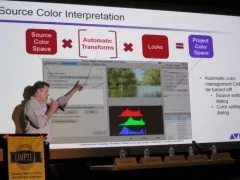On June 3rd the Society of Motion Picture and Television Engineers New York Chapter (SMPTE-NY) had a joint meeting with the Blue Collar Post Collective on High Dynamic Range (HDR) video, especially in terms of HDR content creation and the post-production process.
While most Display Daily readers are familiar with SMPTE, the Blue Collar Post Collective “is an accessible and focused grassroots initiative, supporting young post production professionals in New York.” It is a relatively new organization that launched itself in February, 2015.
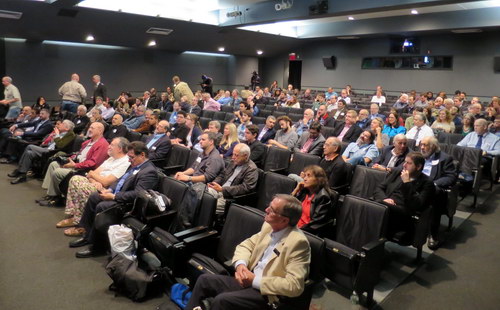 Audience at the SMPTE NY HDR meeting after the speakers, waiting for the panel session to begin
Audience at the SMPTE NY HDR meeting after the speakers, waiting for the panel session to begin
This was more than an ordinary local chapter meeting of a technical society – it provided (for free, including sandwiches!) what would have been an excellent session at a major show like InfoComm or NAB. There were four speakers, including a keynote speaker, plus a panel of six, one of whom attended by Skype. There was little overlap between the speakers and the panel so there were a total of nine presenters who each gave their take on HDR, including the history, current state of the art and the future. According to the SMPTE host, this was the meeting with the highest attendance of any SMPTE-NY meeting in recent history with about 170 attendees.
The keynote speaker was Katie Hinsen from Light Iron, a post production house and a division of Panavision. She spoke on “HDR: New Challenges for Post Production.” She focused on topics such as jitter, judder and other artifacts; eye fatigue and other human factors; and display limitations. These were themes that were continued throughout the evening with the other speakers and the panel session. One thing she talked about that surprised me was that she believed the cinema and post-production for the cinema was playing catch up with the consumer electronics industry, the camera makers and hobbyists. HDR cameras have been available since 2008 and another speaker said later in the evening that virtually all television content is produced in HDR, even though it is not shown that way. At least not to most people. Ms. Hinsen added that Light Iron had already done a HDR TV special and was currently working on the first episodic TV show to be produced entirely (and consciously) in HDR.
She emphasized that over-use of the highlights made possible by HDR could lead to eye fatigue in viewers. She urged the post-production community to use “creative restraint” in applying HDR to content. (Fat Chance!) She didn’t want to see HDR fall into the 3D trap where the post community, aided and abetted by the studios and other content creators, over used the technology and made the content nearly impossible to watch.
Mark Schubin, one of SMPTE-NY’s perennially favorite speakers, talked about some of the technical aspects of HDR from a human factors point of view. One thing he emphasized was that HDR provided the most “bang for the buck” in terms of improved image quality from higher bit rates. He showed data that indicated you needed about 16x the bit rate to get a single visual grade of improvement in image quality and high frame rate (HFR) required about 2x the bit rate to improve by one grade. HDR, however, needs only 1.0 – 1.2x the bit rate to get a one grade improvement. He emphasized that HDR is possible even with the current bit rates. It just depends on how those bits are used, the contrast of the display, etc.
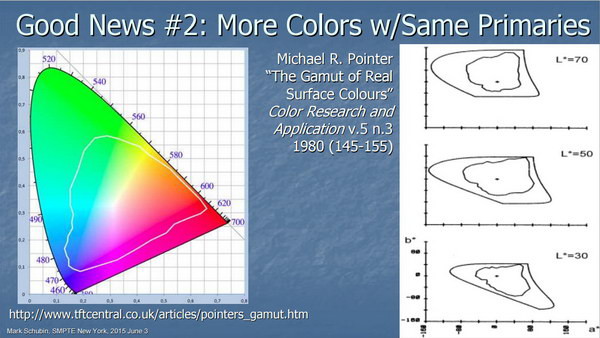 Human factors studies have shown that as brightness increases (L*) the size of the perceived color gamut expands.He also said HDR was a path to better colors, even if the displays remained Rec. 709. It is well known that brighter colors also look more saturated to viewers . This is why content creators need to color grade for each brightness level they expect to be used, including ranging from 3D cinema (the lowest) to HDR TV. Schubin promised to put his slides on-line at the Schubin Café.
Human factors studies have shown that as brightness increases (L*) the size of the perceived color gamut expands.He also said HDR was a path to better colors, even if the displays remained Rec. 709. It is well known that brighter colors also look more saturated to viewers . This is why content creators need to color grade for each brightness level they expect to be used, including ranging from 3D cinema (the lowest) to HDR TV. Schubin promised to put his slides on-line at the Schubin Café.
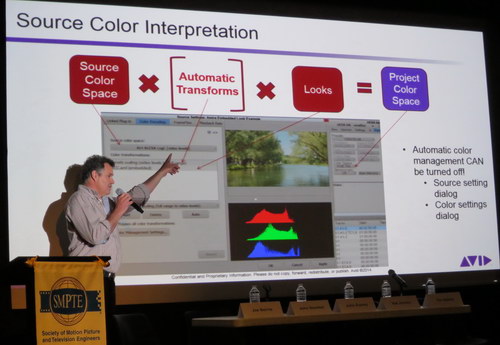 Luc Amiot, Sr. Principal Product Designer at Avid explains how Avid post-production software handles color in HDR content.
Luc Amiot, Sr. Principal Product Designer at Avid explains how Avid post-production software handles color in HDR content.
There were three things all the speakers and panelists were concerned with:
- Human factors, both in the theater and the post-production suite
- Display technology supporting HDR
- Standards supporting HDR
Human factors in the post production suite were a surprising factor discussed by several. Currently in the post-production suite 100 nit monitors are the standard. In HDR, much brighter displays are needed, of 1000 nit and above. One concern was what would happen if a colorist was working on content at the normal 100 nit level, expected to be the bulk of the content even in a HDR show, and he accidentally switches the monitor to a full 1000 nit white screen? The best that could happen is he loses his normal color vision for 10 minutes or so and loses that time at work. The worst that could happen is eye damage, especially since a colorist typically works 10 hour days in dim rooms. A similar thing could happen to the viewers. What happens if an advertiser, to get people’s attention, blasts them with a full white 1000 nit screen? Will the viewers be able to see the next 10 minutes of the show? While the content creation community rarely shows “creative restraint”, the advertising community never does.
Displays are an issue for several reasons. First, there is no standardization: Samsung has a 1000 nit consumer display yet Dolby is pushing its 4000 nit professional display. Display colors aren’t standardized either. (Yes, I know about Rec. 709.) Also, can high-brightness displays meet the California energy consumption requirements?
Standards are an issue as well. For example, Nat Jencks at Outlier Post and an independent film maker said he had not worked in HDR although he was “cautiously hopeful.” One reason he hadn’t worked in HDR was that major production companies with a $100M budget can afford to master their content in 100 or so different formats. An independent film maker with a $5M budget simply cannot afford to do this. One reason he was hopeful was that Indie film makers often use natural light, partly for artistic effect and partly because of the cost of providing complete artificial lighting. With HDR, people and other subjects in the shadows would still be visible.
Bill Miller from SMPTE was not on the panel but spoke from the floor. He urged post houses and indie film makers to join SMPTE and participate in the standards making process. He said this process is currently dominated by the hardware manufacturers who don’t always have the interests of the end users at heart.
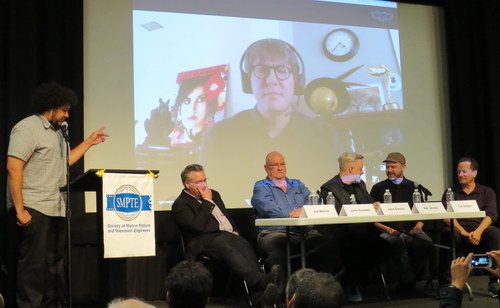 Panel session, with Howard Lukk attending via Skype from California
Panel session, with Howard Lukk attending via Skype from California
Bill Beck, “The Laser Guy” from Barco, was in the audience and I talked to him for a while after the show. He said Dolby, with Dolby Cinema, may be on the right track. In a normal cinema, the light reflected by the walls and ceiling of the auditorium back to the white screen make it nearly impossible to get the black levels needed to fully appreciate HDR content and displays. Dolby Cinema is a complete system including not only projectors but the auditorium itself, where the interior is black or dark gray, increasing the contrast at the screen. He felt that the 25 or so laser cinema installations from Barco and Christie world wide could also be counted in the HDR camp, although that was not their original intention: 3D and wide color gamut was.
SMPTE-NY recorded the entire meeting. Once the local student chapter of SMPTE edits and assembles the video, it will be put on-line for viewing. If you want to know about the state of the art for HDR, it will be worth spending the two hours or so to watch it. I’ll make sure the link is posted to Meko’s Display Daily web site when the video becomes available. –Matthew Brennesholt

